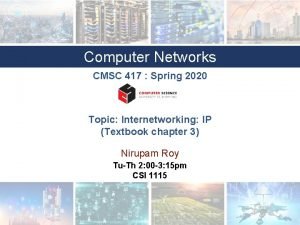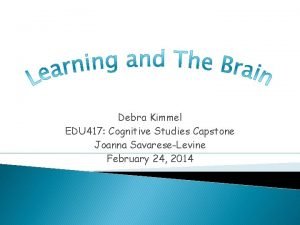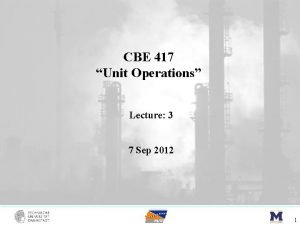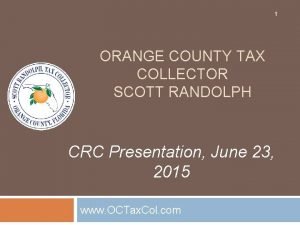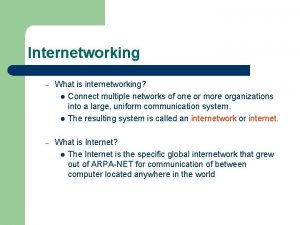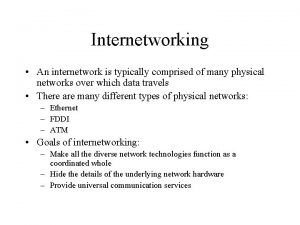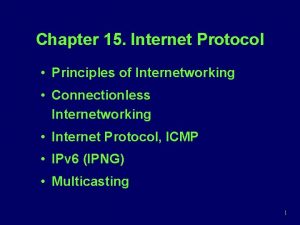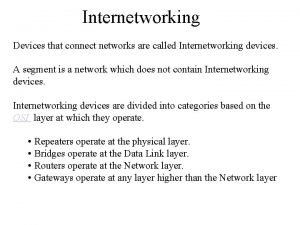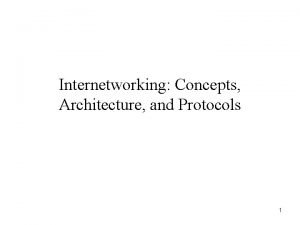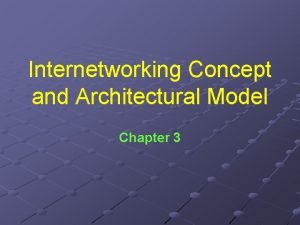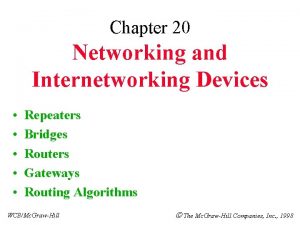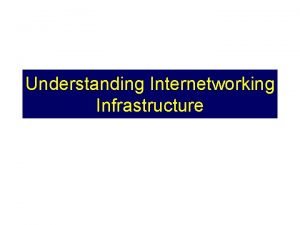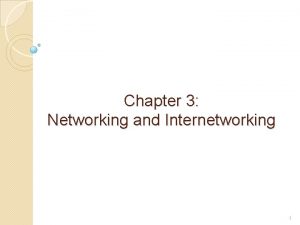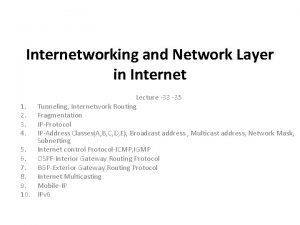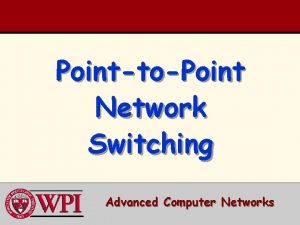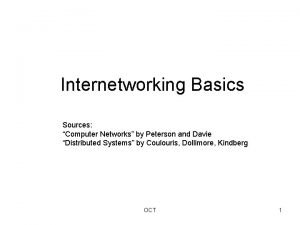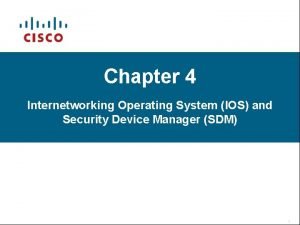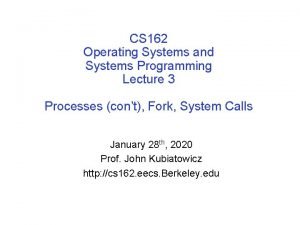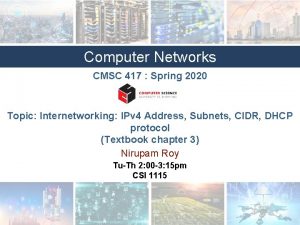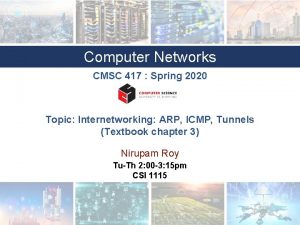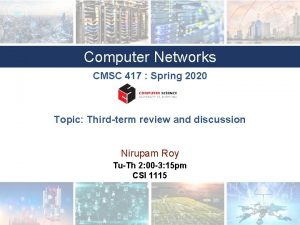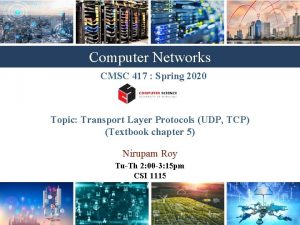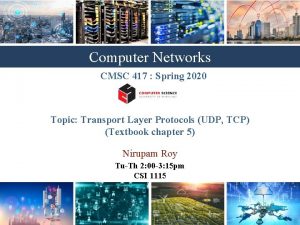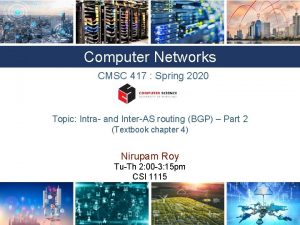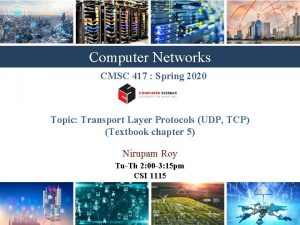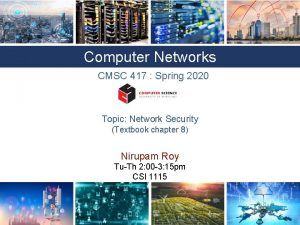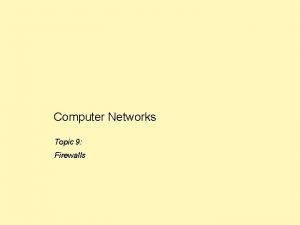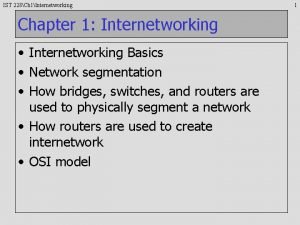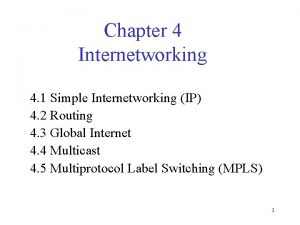Computer Networks CMSC 417 Spring 2020 Topic Internetworking




































- Slides: 36

Computer Networks CMSC 417 : Spring 2020 Topic: Internetworking (Textbook chapter 3) Nirupam Roy Tu-Th 2: 00 -3: 15 pm CSI 1115

Connection between hosts 1. Addressing – Unique identifier for global addressing – Link name for neighbors 2. Forwarding -- Switching packets between links 3. Routing -- Determining paths between hosts

Connection between hosts 1. Addressing – Unique identifier for global addressing – Link name for neighbors 2. Forwarding -- Switching packets between links 3. Routing -- Determining paths between hosts

Routing protocols Routing protocol goal: determine “good” paths (equivalently, routes), from sending hosts to receiving host, through network of routers • path: sequence of routers packets will traverse in going from given initial source host to given final destination host • “good”: least “cost”, “fastest”, “least congested” 4

Graph abstraction of the network 5 2 v u 2 1 graph: G = (N, E) x 3 w 3 1 5 z 1 y 2 N = set of routers = { u, v, w, x, y, z } E = set of links ={ (u, v), (u, x), (v, w), (x, y), (w, z), (y, z) } aside: graph abstraction is useful in other network contexts, e. g. , P 2 P, where N is set of peers and E is set of TCP connections 5

Graph abstraction: costs 5 2 u v 2 1 x 3 w 3 1 5 z 1 y c(x, x’) = cost of link (x, x’) e. g. , c(w, z) = 5 2 cost could always be 1, or inversely related to bandwidth, or related to congestion cost of path (x 1, x 2, x 3, …, xp) = c(x 1, x 2) + c(x 2, x 3) + … + c(xp-1, xp) key question: what is the least-cost path between u and z ? routing algorithm: algorithm that finds that least cost path 6

Routing • For a simple network, we can calculate all shortest paths and load them into some nonvolatile storage on each node. • Such a static approach has several shortcomings • It does not deal with node or link failures • It does not consider the addition of new nodes or links • It implies that edge costs cannot change • What is the solution? • Need a distributed and dynamic protocol • Two main classes of protocols • Distance Vector • Link State

Distance Vector Routing

Distance Vector • Each node constructs a one dimensional array (a vector) containing the “distances” (costs) to all other nodes and distributes that vector to its immediate neighbors • Starting assumption is that each node knows the cost of the link to each of its directly connected neighbors

Distance Vector Routing: An example 19 B A 11 7 C D 4 13 15 5 E

Distance Vector Routing: An example Routing table at Node A Dest Cost N. Hop 19 B A 11 7 C D 4 13 15 5 E

Distance Vector Routing: An example Routing table at Node A Dest Cost N. Hop A 0 A B 19 B C 7 C D ∞ -- E ∞ -- 19 B A 11 7 C D 4 13 15 5 E Know thy neighbors !! How?

Round: 0 Dest Cost N. Hop A 0 A B 19 B C 7 C D ∞ -- E ∞ -- Dest Cost N. Hop A 19 A B 0 B C 11 C D 4 D E ∞ -- 19 B A 7 A ∞ -- B 4 B C 15 C D 0 D E 13 15 5 C N. Hop D 4 11 Dest Cost N. Hop A 7 A B 11 B C 0 C D 15 D E 5 E E Dest Cost N. Hop A ∞ -- B ∞ -- C 5 C D 13 D E 0 E

Round: 0 Dest Cost N. Hop A 19 A B 0 B Dest Cost N. Hop A ∞ -- B 4 B 15 C 0 D 13 E Dest Cost C neighbors 11 C know what you Let your C D 4 D D know!! N. Hop A 0 A B 19 B C 7 C D ∞ -- E ∞ 19 -- B A E 11 7 D 4 13 15 5 C Dest Cost N. Hop A 7 A B 11 B C 0 C D 15 D E 5 E E Dest Cost N. Hop A ∞ -- B ∞ -- C 5 C D 13 D E 0 E

Round: 1 Dest Cost N. Hop A 19 A B 0 B Dest Cost N. Hop A ∞ -- B 4 B 15 C 0 D 13 E Dest Cost C 11 C Update your routing table, if. C D 4 D D required!! N. Hop A 0 A B 19 B C 7 C D ∞ -- E Node A: Updates for B, D, E Node B: Updates for A, E Node C: No Updates Node D: Updates for A Node E: Updates for A, B ∞ 19 -- B A E 11 7 D 4 13 15 5 C Dest Cost N. Hop A 7 A B 11 B C 0 C D 15 D E 5 E E Dest Cost N. Hop A ∞ -- B ∞ -- C 5 C D 13 D E 0 E

Round: 1 Dest Cost N. Hop A 0 A B 18 C C 7 C D 22 C E 12 C Dest Cost N. Hop A 18 C B 0 B C 11 C D 4 D E 16 C Node A: Updates for B, D, E Node B: Updates for A, E Node C: No Updates Node D: Updates for A Node E: Updates for A, B 19 B A 7 A 22 C B 4 B C 15 C D 0 D E 13 15 5 C N. Hop D 4 11 Dest Cost N. Hop A 7 A B 11 B C 0 C D 15 D E 5 E E Dest Cost N. Hop A 12 C B 16 C C 5 C D 13 D E 0 E

Round: 1 Dest Cost N. Hop A 0 A B 18 C C 7 C D 22 C E 12 C Dest Cost N. Hop A 18 C B 0 B C 11 C D 4 D E 16 C Node A: Updates for B, D, E Node B: Updates for A, E Node C: No Updates Node D: Updates for A Node E: Updates for A, B 19 B A 7 A 22 C B 4 B C 15 C D 0 D E 13 15 5 C N. Hop D 4 11 Dest Cost N. Hop A 7 A B 11 B C 0 C D 15 D E 5 E E Dest Cost N. Hop A 12 C B 16 C C 5 C D 13 D E 0 E

Round: 2 Dest Cost N. Hop A 0 A B 18 C C 7 C D 22 C E 12 C Node A: No Updates Node B: No Updates Node C: No Updates Node D: No Updates Node E: No Updates Dest Cost N. Hop A 18 C B 0 B C 11 C D 4 D E 16 C 19 B A 7 N. Hop A 22 C B 4 B C 15 C D 0 D E 13 E D 4 11 Dest Cost 15 13 5 Convergence C E Dest Cost N. Hop A 7 A B 11 B C 0 C D 15 D E 5 E Dest Cost N. Hop A 12 C B 16 C C 5 C D 13 D E 0 E

Distance vector algorithm Bellman-Ford equation (dynamic programming) let dx(y) : = cost of least-cost path from x to y then dx(y) = min {c(x, v) + dv(y) } v cost from neighbor v to destination y cost to neighbor v min taken over all neighbors v of x 19

Bellman-Ford example 5 2 u v 2 1 x 3 w 3 1 clearly, dv(z) = 5, dx(z) = 3, dw(z) = 3 5 z 1 y 2 B-F equation says: du(z) = min { c(u, v) + dv(z), c(u, x) + dx(z), c(u, w) + dw(z) } = min {2 + 5, 1 + 3, 5 + 3} = 4 node achieving minimum is next hop in shortest path, used in forwarding table 20

Distance vector algorithm • Dx(y) = estimate of least cost from x to y • x maintains distance vector Dx = [Dx(y): y є N ] • node x: • knows cost to each neighbor v: c(x, v) • maintains its neighbors’ distance vectors. For each neighbor v, x maintains Dv = [Dv(y): y є N ] 21

Distance vector algorithm key idea: • from time-to-time, each node sends its own distance vector estimate to neighbors • when x receives new DV estimate from neighbor, it updates its own DV using B-F equation: Dx(y) ← minv{c(x, v) + Dv(y)} for each node y ∊ N v under minor, natural conditions, the estimate Dx(y) converge to the actual least cost dx(y) 22

Distance vector algorithm iterative, asynchronous: each node: each local iteration caused by: • local link cost change • DV update message from neighbor wait for (change in local link distributed: recompute estimates • each node notifies neighbors only when its DV changes • neighbors then notify their neighbors if necessary cost or msg from neighbor) if DV to any dest has changed, notify neighbors 23

Routing updates Two circumstances when a node sends out routing advertisements: 1) Periodic update: Automatically after some time. Why? 2) Triggered update: Whenever an event makes a node to change its routing table (e. g. , link fail or a new message from a neighbor).

Distance Vector Routing: Link failure

Round: 2 Dest Cost N. Hop A 0 A B 18 C C 7 C D 22 C E 12 C Node A: No Updates Node B: No Updates Node C: No Updates Node D: No Updates Node E: No Updates Dest Cost N. Hop A 18 C B 0 B C 11 C D 4 D E 16 C 19 B A 7 A 22 C B 4 B C 15 C D 0 D E 13 15 5 C N. Hop D 4 11 Dest Cost N. Hop A 7 A B 11 B C 0 C D 15 D E 5 E E Dest Cost N. Hop A 12 C B 16 C C 5 C D 13 D E 0 E

Round: 3 Dest Cost N. Hop A 0 A B 18 C C 7 C D 22 C E 12 C Node A: No Updates Node B: No Updates Node C: No Updates Node D: No Updates Node E: No Updates Dest Cost N. Hop A ∞ -- B 0 B C ∞ -- D 4 D E ∞ -- 19 B A 7 A 22 C B 4 B C 15 C D 0 D E 13 15 5 C N. Hop D 4 11 Dest Cost N. Hop A 7 A B ∞ -- C 0 C D 15 D E 5 E E Dest Cost N. Hop A 12 C B 16 C C 5 C D 13 D E 0 E

Round: 3 Dest Cost N. Hop A 0 A B ∞ C C 7 C D 22 C E 12 C Dest Cost N. Hop A 19 A B 0 B C 19 D D 4 D E 17 D Node A: Updates for B Node B: Updates for A, C, E Node C: Updates for B Node D: No Updates Node E: Updates for B 19 Cost update B A 7 A 22 C B 4 B C 15 C D 0 D E 13 15 5 C N. Hop D 4 11 Dest Cost N. Hop A 7 A B 19 D C 0 C D 15 D E 5 E E Dest Cost N. Hop A 12 C B 17 D C 5 C D 13 D E 0 E

Round: 4 Dest Cost N. Hop A 0 A B ∞ C C 7 C D 22 C E 12 C Node A: Updates for B Node B: No Updates Node C: No Updates Node D: No Updates Node E: No Updates Dest Cost N. Hop A 19 A B 0 B C 19 D D 4 D E 17 D 19 B A 7 A 22 C B 4 B C 15 C D 0 D E 13 15 5 C N. Hop D 4 11 Dest Cost N. Hop A 7 A B 19 D C 0 C D 15 D E 5 E E Dest Cost N. Hop A 12 C B 17 D C 5 C D 13 D E 0 E

Round: 5 Dest Cost N. Hop A 0 A B 19 B C 7 C D 22 C E 12 C Node A: No Updates Node B: No Updates Node C: No Updates Node D: No Updates Node E: No Updates Dest Cost N. Hop A 19 A B 0 B C 19 D D 4 D E 17 D 19 B A 7 A 22 C B 4 B C 15 C D 0 D E 13 15 5 C N. Hop D 4 11 Dest Cost N. Hop A 7 A B 19 D C 0 C D 15 D E 5 E E Dest Cost N. Hop A 12 C B 17 D C 5 C D 13 D E 0 E

Distance vector: link cost changes: v v v node detects local link cost change updates routing info, recalculates distance vector if DV changes, notify neighbors 1 4 x y 50 1 z

Distance vector: link cost decreases Y’s routing table Dest. Z’s routing table

Distance vector: link cost decreases Dest.

Distance vector: link cost changes: v v v node detects local link cost change updates routing info, recalculates distance vector if DV changes, notify neighbors “good news travels fast” 1 4 x y 50 1 z t 0 : y detects link-cost change, updates its DV, informs its neighbors. t 1 : z receives update from y, updates its table, computes new least cost to x , sends its neighbors its DV. t 2 : y receives z’s update, updates its distance table. y's least costs do not change, so y does not send a message to z. 34

Distance vector: link cost changes: v v v node detects local link cost change bad news travels slow - “count to infinity” problem! Many iterations before algorithm stabilizes 60 x 4 y 50 1 z 35

Distance vector: link cost increases “Count to infinity” problem
 Cmsc 417
Cmsc 417 Cmsc 417
Cmsc 417 Cmsc 417
Cmsc 417 Internetwork
Internetwork Datagram switching vs virtual circuit switching
Datagram switching vs virtual circuit switching Basestore iptv
Basestore iptv Southwest flight 417
Southwest flight 417 417 studies
417 studies 417 toll rates
417 toll rates Ece 417 uiuc
Ece 417 uiuc Cbe 417
Cbe 417 Research objectives
Research objectives Ece 417
Ece 417 Stripping rectifying section
Stripping rectifying section Scott randolph property tax
Scott randolph property tax Spring, summer, fall, winter... and spring cast
Spring, summer, fall, winter... and spring cast Winter is white spring is green
Winter is white spring is green Decision tree
Decision tree L connect 2
L connect 2 What is internetworking
What is internetworking Istilah internet berasal dari kata
Istilah internet berasal dari kata Principles of internetworking
Principles of internetworking Internet working devices
Internet working devices Internetworking concepts
Internetworking concepts Internetworking concept and architectural model
Internetworking concept and architectural model Networking and internetworking devices
Networking and internetworking devices Internetworking business model
Internetworking business model Internetworking basics
Internetworking basics Internetworking in network layer
Internetworking in network layer Connectionless internetworking
Connectionless internetworking Fileserver138
Fileserver138 Internetworking operating system
Internetworking operating system Lead paragraph example
Lead paragraph example Topic about internet
Topic about internet Spring io conference 2020
Spring io conference 2020 Math enrichment spring 2020
Math enrichment spring 2020 Cs162 spring 2020
Cs162 spring 2020



